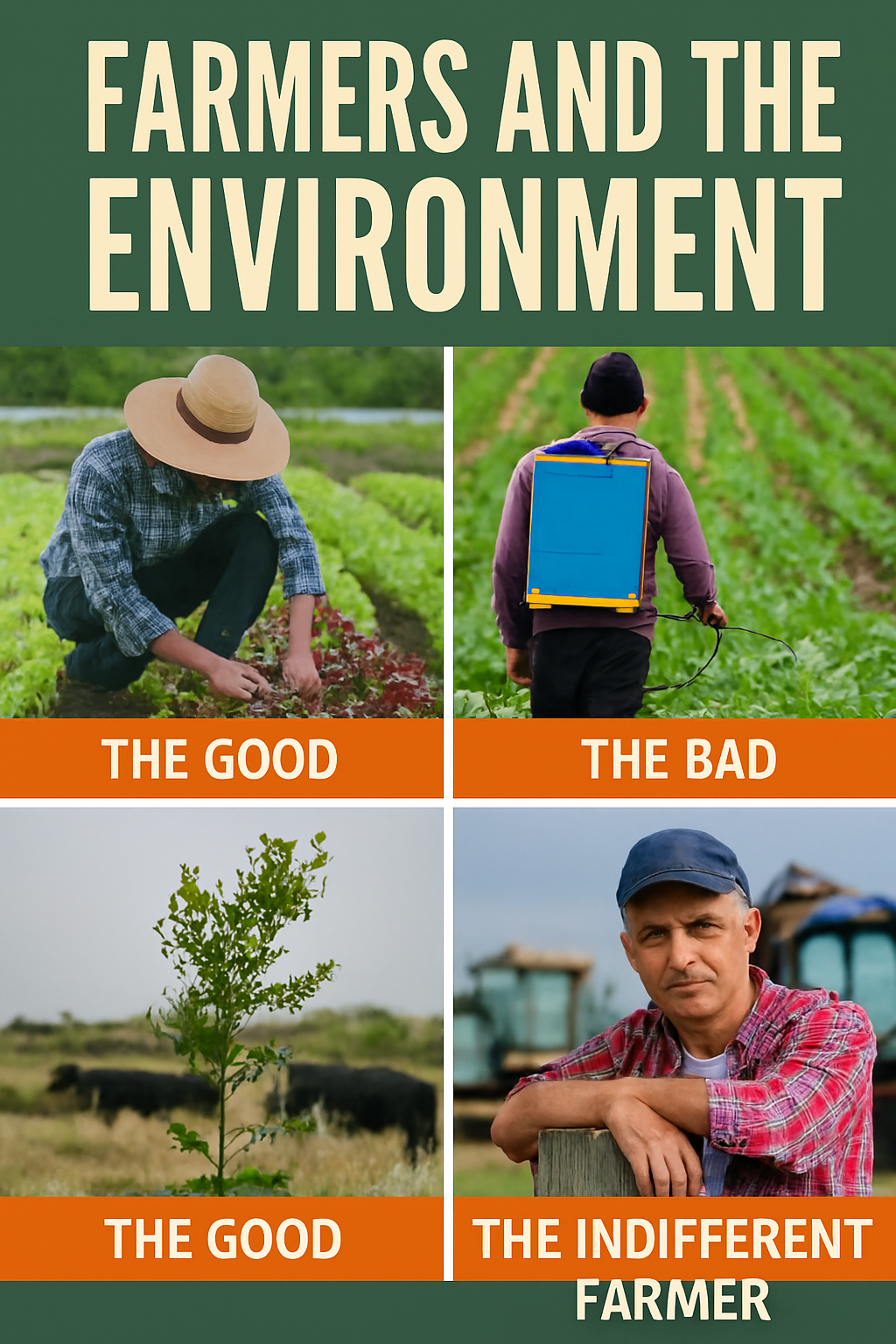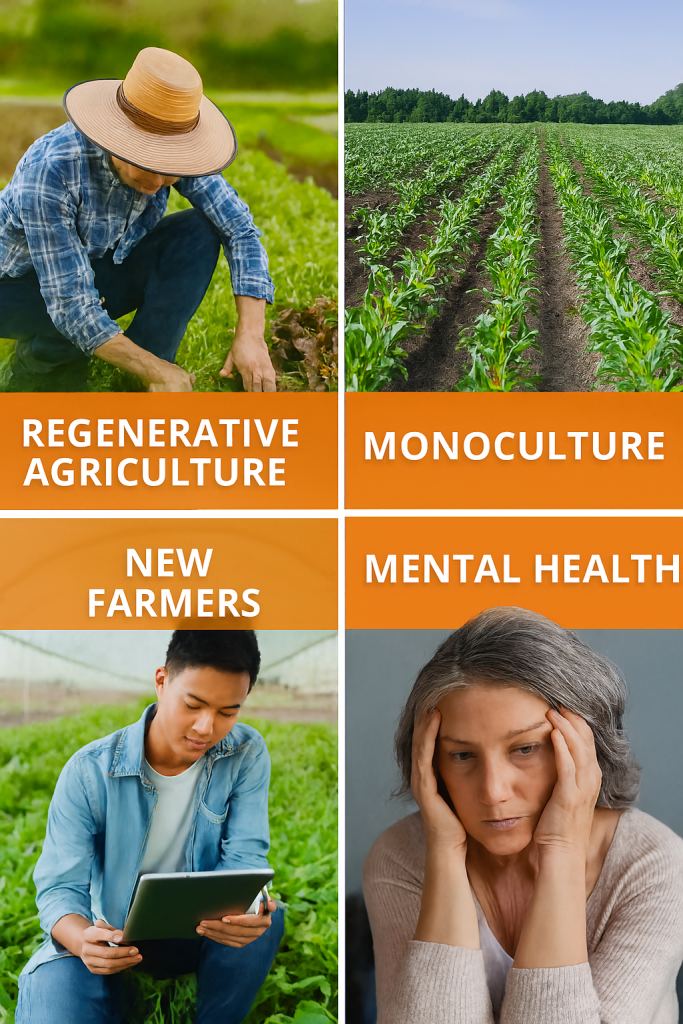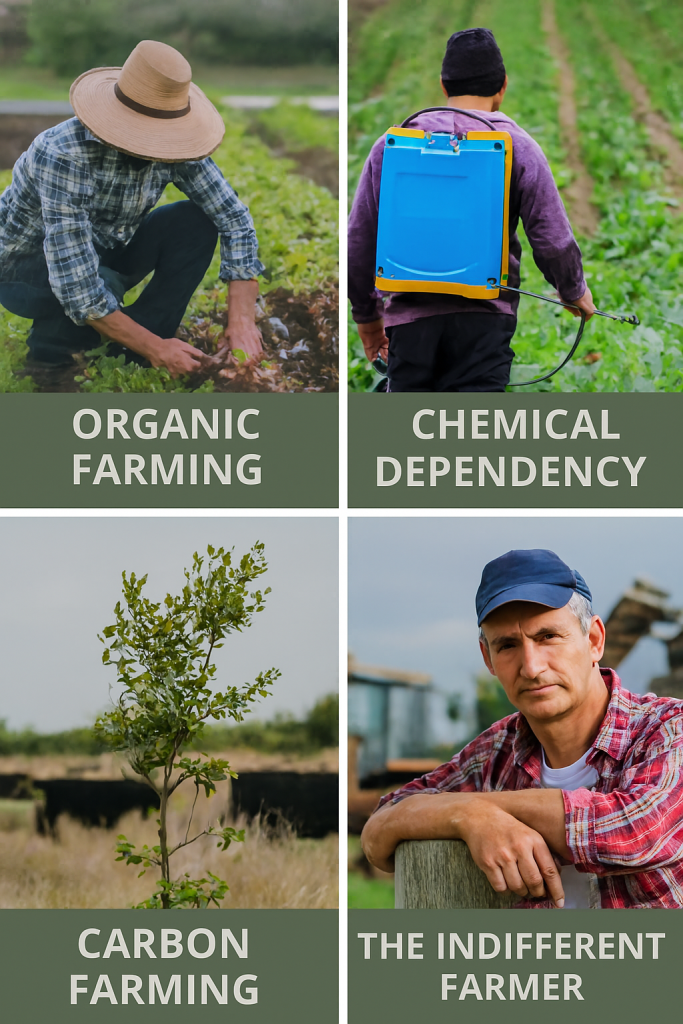
The Farming Life
Farmers And The Environment Strong Psychology – A Landscape Of Complexity And Contradiction
Farmers And The Environment Strong Psychology is one of humanity’s oldest and most essential practices, yet its relationship with the environment is anything but simple. Across continents and cultures, farmers are both stewards of the land and contributors to its degradation. The tension between productivity and sustainability defines modern agriculture. Climate change, biodiversity loss, and soil degradation are pressing concerns, but so are food security, rural livelihoods, and economic survival. Some farmers lead the charge in regenerative practices, while others remain locked in extractive cycles. The environmental impact of farming varies widely depending on geography, crop type, scale, and policy.

The Farmers Sustainable Techniques
Regenerative Farming – Soil As A Living System
Regenerative farming treats soil not as a substrate but as a living ecosystem. Farmers who adopt this approach prioritize soil health through composting, cover cropping, and reduced tillage. These practices increase microbial diversity, improve water retention, and sequester carbon. Regenerative systems often integrate livestock in rotational grazing patterns that mimic natural cycles. The result is a landscape that heals itself over time. Unlike conventional monoculture, regenerative farms embrace polyculture and perennial crops. They rely less on synthetic inputs and more on ecological balance. Farmers report improved yields over time and greater resilience to drought and flood. The philosophy behind regenerative farming is rooted in reciprocity—giving back to the land as much as it gives. It’s not just a technique but a worldview that sees agriculture as part of a larger ecological web.
| Practice | Environmental Benefit | Long-Term Impact |
|---|---|---|
| Cover Cropping | Reduces erosion | Builds soil fertility |
| No-Till Farming | Preserves soil structure | Enhances carbon storage |
| Rotational Grazing | Mimics natural cycles | Restores grasslands |
| Compost Application | Boosts microbial activity | Reduces chemical use |
| Polyculture Planting | Increases biodiversity | Stabilizes ecosystems |
Industrial Agriculture – Efficiency At A Cost
Industrial agriculture prioritizes scale, speed, and uniformity. It relies heavily on synthetic fertilizers, pesticides, and genetically modified crops. These systems produce high yields but often degrade soil, pollute waterways, and reduce biodiversity. Large monoculture farms are vulnerable to pests and climate shocks, requiring constant chemical intervention. The environmental cost includes greenhouse gas emissions from machinery, fertilizer production, and livestock. Industrial farms often externalize their ecological damage, passing the cost to surrounding communities. While efficient in terms of output, they are inefficient in terms of resource use and long-term sustainability. Critics argue that industrial agriculture treats land as a factory floor rather than a living system. The debate continues, but the environmental toll is increasingly hard to ignore.
- Industrial farms emit significant methane and nitrous oxide from livestock and fertilizer use
- Monoculture reduces genetic diversity and increases vulnerability to disease
- Chemical runoff contributes to dead zones in rivers and oceans
- Heavy machinery compacts soil and reduces its ability to absorb water
- Irrigation systems often deplete aquifers and disrupt local hydrology
- Pesticides harm pollinators and disrupt food chains
- Fertilizer overuse leads to algal blooms and aquatic die-offs
- Land clearing for industrial farms accelerates deforestation
- Waste from concentrated animal feeding operations contaminates groundwater
- Industrial systems often displace smallholder farmers and reduce rural resilience
Climate-Conscious Farmers – Adaptation And Innovation
Farmers on the frontlines of climate change are adapting in creative ways. In drought-prone regions, they are shifting to water-efficient crops and investing in drip irrigation. In flood-prone areas, they are building raised beds and planting flood-tolerant varieties. Some are experimenting with agroforestry—integrating trees into cropland to stabilize soil and provide shade. Others are using satellite data and AI to optimize planting schedules and reduce waste. Climate-conscious farmers often participate in carbon markets, earning credits for practices that reduce emissions. They also engage in community-based monitoring to track local climate shifts. These farmers are not passive victims but active agents of change. Their innovations reflect a deep understanding of local ecosystems and a willingness to evolve. Climate resilience in agriculture is not just about technology—it’s about mindset, collaboration, and long-term thinking.
| Region | Climate Challenge | Farmer Response |
|---|---|---|
| Northern NSW | Drought | Switch to millet and sorghum |
| Victoria | Flooding | Raised beds and drainage systems |
| Tasmania | Frost variability | Frost-resistant crop varieties |
| WA Wheatbelt | Heat stress | Shade trees and mulching |
| SA Riverlands | Water scarcity | Drip irrigation and soil sensors |
Organic Farming – Purity And Perception
Organic farming is often seen as the gold standard for environmentally friendly agriculture. It avoids synthetic pesticides and fertilizers, relying instead on natural inputs like compost, manure, and biological pest control. Organic certification requires strict adherence to soil health, biodiversity, and animal welfare standards. Many organic farmers use crop rotation and intercropping to maintain fertility and reduce pest pressure. However, organic yields can be lower than conventional ones, raising questions about scalability. Critics argue that organic farming is not always more sustainable, especially when transportation and packaging are considered. Still, organic farms tend to have quality, and healthier soils and more diverse microbial ecosystems. Consumers often choose organic for health and ethical reasons, reinforcing market demand. The environmental benefits are real but vary depending on implementation. Organic farming is a step toward sustainability, but not a panacea.
| Feature | Organic Approach | Environmental Impact |
|---|---|---|
| Fertilizer Use | Compost and manure | Reduces chemical runoff |
| Pest Control | Biological methods | Protects pollinators |
| Soil Management | Crop rotation | Enhances soil structure |
| Animal Welfare | Free-range and humane care | Reduces stress and disease |
| Certification Standards | Third-party audits | Ensures compliance |
Conventional Farming – Tradition And Trade-Offs
Conventional farming dominates global agriculture due to its efficiency and scalability. It uses synthetic inputs to maximize yield and minimize labor. These systems are often mechanized, allowing large-scale production with fewer workers. However, the environmental costs include soil erosion, water pollution, and loss of biodiversity. Conventional farmers face pressure from markets, subsidies, and consumer demand. Many are aware of the ecological impact but feel trapped by economic realities. Transitioning to sustainable methods can be costly and risky. Conventional farming is not inherently harmful, but its widespread practices often prioritize short-term gains over long-term health. The challenge is balancing productivity with stewardship. Some conventional farmers are adopting hybrid models, integrating sustainable techniques without abandoning their core systems.
- Conventional farming often relies on fossil fuels for machinery and transport
- Synthetic fertilizers contribute to nitrous oxide emissions, a potent greenhouse gas
- Pesticide use can lead to resistance and ecological imbalance
- Irrigation systems may overdraw local water sources
- Soil compaction from heavy equipment reduces fertility
- Crop residues are often burned, releasing carbon into the atmosphere
- Livestock operations may produce excess waste without proper treatment
- Conventional systems can be vulnerable to market volatility
- Farmers may lack access to training in sustainable alternatives
- Policy incentives often favor conventional over regenerative practices
Agroecology – Farming With Nature
Agroecology blends scientific knowledge with traditional practices to create resilient farming systems. It emphasizes ecological principles such as nutrient cycling, biodiversity, and energy efficiency. Agroecological farms often use mixed cropping, agroforestry, and integrated pest management. These systems are tailored to local conditions, making them highly adaptable. Farmers practicing agroecology often collaborate with researchers and communities to share knowledge. The approach values cultural traditions and indigenous wisdom alongside modern science. Agroecology is not just a method but a movement—advocating for food sovereignty and ecological justice. It challenges the industrial model by prioritizing relationships over inputs. The environmental benefits include improved soil health, reduced emissions, and enhanced biodiversity. Agroecology is gaining traction globally, especially in regions facing climate stress and resource scarcity.
| Principle | Agroecological Practice | Ecological Outcome |
|---|---|---|
| Biodiversity | Mixed cropping and hedgerows | Habitat creation |
| Nutrient Cycling | Compost and green manure | Soil enrichment |
| Water Conservation | Mulching and contour farming | Reduced runoff |
| Pest Management | Natural predators and traps | Lower chemical use |
| Community Engagement | Farmer-researcher networks | Knowledge sharing |
Livestock Farming – Emissions And Ethics
Livestock farming is a major contributor to greenhouse gas emissions, especially methane from ruminants. It also raises ethical concerns about animal welfare and land use. Intensive livestock systems, such as feedlots, concentrate animals in confined spaces, often leading to pollution and disease. Extensive systems, like pasture-based grazing, can be more sustainable but require more land. Manure management is a key issue—poor handling can contaminate water and release harmful gases. Some farmers are exploring alternative feeds to reduce methane production. Others are investing in anaerobic digesters to convert waste into energy. Livestock farming intersects with cultural traditions, dietary habits, and economic livelihoods. The environmental impact depends on scale, management, and geography. Ethical farming practices can reduce harm, but systemic change is needed to align livestock production with ecological limits.
- Livestock farming accounts for over 14% of global greenhouse gas emissions
- Methane from cattle is 25 times more potent than CO₂ over a 100-year period
- Feed production often involves deforestation and monoculture
- Antibiotic use in livestock can lead to resistant bacteria
- Manure runoff pollutes rivers and lakes
- Animal welfare varies widely across farming systems
- Grazing can either degrade or restore landscapes depending on management
- Alternative proteins are emerging as a response to livestock impact
- Cultural preferences influence livestock demand and farming practices
- Policy reform is needed to incentivize low-impact livestock systems
Smallholder Farmers – Custodians Of Local Ecosystems
Smallholder farmers manage nearly a third of the world’s agricultural land, often using traditional methods passed down through generations. Their farms are typically diverse, with multiple crops and livestock integrated into a single system. These farmers tend to rely on local knowledge, seasonal rhythms, and manual labor rather than industrial inputs. Because of their scale and practices, smallholders often have a lower environmental footprint. However, they face challenges such as limited access to credit, markets, and climate-resilient infrastructure. Many smallholders are vulnerable to land grabs, policy neglect, and extreme weather events. Despite these pressures, they play a crucial role in preserving agrobiodiversity and cultural heritage. Their contributions to food security and ecological stewardship are often undervalued. Supporting smallholder farmers is not just an economic issue—it’s an environmental imperative. Their survival is tied to the health of the landscapes they inhabit.
| Characteristic | Smallholder Farming Traits | Environmental Implication |
|---|---|---|
| Farm Size | Less than 2 hectares | Lower resource intensity |
| Crop Diversity | Mixed cropping systems | Supports biodiversity |
| Input Use | Minimal synthetic inputs | Reduces pollution |
| Labor | Family-based manual labor | Low carbon footprint |
| Knowledge Base | Indigenous and local wisdom | Enhances ecological fit |
Precision Agriculture – Data-Driven Stewardship
Precision agriculture uses technology to optimize farming decisions and reduce waste. Tools like GPS-guided tractors, soil sensors, and drone imaging allow farmers to apply inputs only where needed. This reduces fertilizer runoff, pesticide overuse, and water waste. Precision systems can also monitor crop health and predict yields with high accuracy. Farmers using these tools often report increased efficiency and reduced environmental impact. However, access to precision tech is uneven—many smallholders lack the capital or infrastructure to adopt it. There’s also a learning curve, requiring training and digital literacy. Despite these barriers, precision agriculture represents a shift toward smarter, more responsive farming. It aligns productivity with sustainability, offering a path forward for tech-savvy growers. The challenge is making these tools accessible and adaptable across diverse farming contexts.
- GPS-guided equipment reduces overlap and fuel use during planting and harvesting
- Soil sensors help farmers apply fertilizer only where nutrient levels are low
- Drones can detect pest outbreaks early, reducing blanket pesticide application
- Variable rate irrigation systems conserve water by targeting dry zones
- Satellite imagery helps monitor crop stress and plan interventions
- Data analytics allow farmers to track input-output ratios and adjust practices
- Precision tools can reduce greenhouse gas emissions from over-fertilization
- Adoption is higher in developed regions with strong tech infrastructure
- Training programs are essential to bridge the digital divide in agriculture
- Precision farming supports both economic and ecological goals when scaled equitably
Permaculture – Designing For Permanence
Permaculture is a design philosophy that mimics natural ecosystems to create sustainable human habitats. In agriculture, it involves creating closed-loop systems where waste becomes input and diversity is prioritized. Farmers practicing permaculture often use swales, food forests, and perennial crops. These systems require careful planning but offer long-term resilience. Permaculture farms tend to be low-input and high-diversity, supporting pollinators and wildlife. The emphasis is on observation, integration, and minimal disturbance. Unlike conventional farming, permaculture avoids tilling, monoculture, and synthetic chemicals. It’s especially popular among homesteaders, educators, and ecological activists. While not always scalable to industrial levels, permaculture offers a blueprint for sustainable living. Its principles can be adapted to urban gardens, rural plots, and community farms. The environmental benefits include carbon sequestration, water conservation, and biodiversity enhancement.
| Element | Permaculture Feature | Ecological Function |
|---|---|---|
| Swales | Contour ditches | Captures rainwater |
| Food Forests | Layered planting | Mimics forest ecology |
| Perennial Crops | Long-lived species | Reduces soil disturbance |
| Compost Toilets | Waste recycling | Nutrient cycling |
| Polyculture Beds | Mixed species | Pest resistance and diversity |
Chemical Dependency – The Pesticide Dilemma
Many farmers rely on chemical pesticides and herbicides to protect crops and ensure yield. While effective in the short term, these substances often harm non-target species and disrupt ecosystems. Pollinators like bees and butterflies are particularly vulnerable, as are aquatic organisms affected by runoff. Over time, pests can develop resistance, leading to a cycle of escalating chemical use. Some farmers feel trapped—unable to afford alternatives or risk lower yields. Regulatory frameworks vary widely, with some countries banning certain chemicals while others continue widespread use. The environmental toll includes soil degradation, water contamination, and loss of biodiversity. Integrated pest management offers a middle path, combining biological controls with targeted chemical use. Education and access to alternatives are key to reducing dependency. The pesticide dilemma is not just technical—it’s economic, cultural, and political.
- Pesticide runoff contributes to eutrophication in lakes and rivers
- Neonicotinoids have been linked to bee population declines
- Herbicides can reduce soil microbial diversity
- Resistance in pests leads to higher doses and more toxic compounds
- Farmers often lack access to training in non-chemical pest control
- Organic alternatives may be costlier or less effective in certain climates
- Crop insurance policies sometimes favor chemical-intensive practices
- Public pressure and consumer demand influence pesticide use
- Regulatory gaps allow continued use of banned substances in some regions
- Transitioning away from chemicals requires systemic support and incentives
Water Management – Scarcity And Stewardship
Water is the lifeblood of agriculture, yet it is increasingly scarce in many farming regions. Farmers must balance the need for irrigation with the responsibility to conserve shared water resources. Over-extraction from rivers and aquifers can lead to ecological collapse, while inefficient irrigation wastes precious supplies. Some farmers are adopting drip systems, rainwater harvesting, and soil moisture sensors to improve efficiency. Others are planting drought-resistant crops or shifting planting schedules to align with rainfall patterns. In flood-prone areas, water management also involves drainage, levees, and wetland restoration. Climate change is intensifying both droughts and floods, making adaptive water strategies essential. Policy frameworks often lag behind, failing to incentivize sustainable water use. Community-based water governance offers a promising model for equitable distribution. Ultimately, water stewardship is a shared responsibility that requires both innovation and cooperation.
| Water Challenge | Farming Response | Environmental Outcome |
|---|---|---|
| Drought | Drip irrigation | Reduced water consumption |
| Flooding | Raised beds and levees | Minimized crop loss |
| Salinization | Crop rotation and leaching | Soil recovery |
| Aquifer depletion | Rainwater harvesting | Groundwater recharge |
| Runoff pollution | Buffer strips and wetlands | Improved water quality |
Biodiversity Loss – The Silent Crisis
Modern agriculture is a leading driver of biodiversity loss, both on farms and in surrounding ecosystems. Monoculture farming reduces habitat complexity, leaving little room for native species. Pesticides and herbicides further diminish insect and bird populations. The loss of hedgerows, wetlands, and forest patches fragments habitats and disrupts migration routes. Genetic diversity within crops and livestock is also declining, making food systems more vulnerable to disease and climate shocks. Some farmers are reversing this trend by planting native species, maintaining wild corridors, and preserving heirloom varieties. Agroforestry and silvopasture systems support both production and habitat. Biodiversity is not just an environmental concern—it underpins pollination, pest control, and soil health. Without it, agricultural systems become brittle and dependent on external inputs. Rebuilding biodiversity requires a shift from extraction to regeneration. Farmers are key actors in this transformation.
- Monoculture fields support fewer pollinators and beneficial insects
- Loss of native vegetation reduces habitat for birds and mammals
- Pesticides can disrupt entire food webs, not just target pests
- Genetic uniformity in crops increases risk of disease outbreaks
- Traditional seed varieties are being lost to commercial hybrids
- Biodiverse farms are more resilient to climate variability
- Hedgerows and buffer zones provide shelter for wildlife
- Crop-livestock integration supports microbial and faunal diversity
- Biodiversity enhances ecosystem services like nutrient cycling and water filtration
- Farmers can access incentives for conservation through agri-environment schemes
Carbon Farming – Sequestering Hope In Soil
Carbon farming refers to agricultural practices that capture and store atmospheric carbon in soil and vegetation. Techniques include cover cropping, reduced tillage, agroforestry, and compost application. These methods not only reduce emissions but also improve soil fertility and water retention. Some farmers participate in carbon credit markets, earning income for verified sequestration. The science behind carbon farming is evolving, with debates about measurement and permanence. Still, it represents a promising intersection of climate action and rural livelihoods. Carbon farming requires long-term commitment and careful monitoring. It also depends on supportive policy and transparent verification systems. Farmers who adopt these practices often report co-benefits like improved yields and drought resilience. Carbon farming is not a silver bullet, but it’s a valuable tool in the climate toolbox. Its success depends on scale, integrity, and farmer engagement.
| Practice | Carbon Sequestration Potential | Co-Benefits |
|---|---|---|
| Cover Cropping | Moderate | Erosion control |
| No-Till Farming | High | Soil structure preservation |
| Agroforestry | Very High | Biodiversity enhancement |
| Compost Application | Moderate | Nutrient cycling |
| Rotational Grazing | Variable | Grassland restoration |
Land Use Change – Expansion And Encroachment
Agricultural expansion is a major driver of deforestation, wetland loss, and grassland degradation. As demand for food, fuel, and fiber grows, more land is converted to cropland and pasture. This often comes at the expense of carbon-rich ecosystems and indigenous territories. Land clearing releases stored carbon, disrupts water cycles, and fragments habitats. In some regions, land grabs displace local communities and undermine food sovereignty. Farmers may be incentivized to expand rather than intensify, especially when land is cheap and regulation is weak. Sustainable intensification—producing more on existing land—is one alternative. Land sparing and land sharing are two competing strategies for balancing production and conservation. The environmental impact of land use change depends on governance, enforcement, and land tenure systems. Farmers are not always the drivers of expansion—they are often responding to market signals and policy gaps. Addressing land use change requires systemic reform, not just individual action.
- Deforestation for agriculture accounts for a significant share of global carbon emissions
- Wetland drainage reduces biodiversity and increases flood risk
- Grassland conversion disrupts carbon and nitrogen cycles
- Land grabs often target areas with high ecological and cultural value
- Land tenure insecurity discourages long-term stewardship
- Sustainable intensification can reduce pressure on wildlands
- Agroecological zoning helps guide land use decisions
- Payments for ecosystem services can incentivize conservation
- Satellite monitoring improves enforcement of land use regulations
- Indigenous land rights are critical to protecting biodiverse landscapes
Urban Farming – Green Patches In Concrete Landscapes
Urban farming brings agriculture into cities, transforming rooftops, balconies, and vacant lots into productive spaces. These farms reduce food miles, reconnect people with food systems, and offer ecological benefits in dense environments. Urban farmers often use raised beds, hydroponics, and vertical systems to maximize space. Composting and rainwater harvesting are common practices, turning waste into resources. While small in scale, urban farms contribute to biodiversity, carbon sequestration, and community resilience. They also serve educational and therapeutic roles, especially in underserved neighborhoods. Challenges include zoning laws, soil contamination, and access to land. Despite these hurdles, urban farming is growing globally, supported by grassroots movements and municipal programs. It reimagines cities as ecosystems, not just infrastructure. Farmers in urban settings are not just producers—they’re educators, activists, and innovators.
| Feature | Urban Farming Practice | Environmental Benefit |
|---|---|---|
| Space Efficiency | Vertical gardens | Maximizes limited area |
| Waste Reduction | Composting | Diverts organic waste |
| Water Conservation | Rainwater harvesting | Reduces municipal demand |
| Biodiversity | Native plant integration | Supports pollinators |
| Community Engagement | Shared garden plots | Builds ecological awareness |

Policy And Incentives – Shaping Agricultural Behavior
Government policies play a critical role in shaping how farmers interact with the environment. Subsidies, tax breaks, and grants can either encourage sustainable practices or entrench harmful ones. In some regions, farmers receive payments for ecosystem services—such as maintaining wetlands or planting cover crops. Other programs penalize pollution or reward carbon sequestration. However, policy frameworks are often fragmented, inconsistent, or poorly enforced. Farmers may struggle to navigate bureaucracy or meet eligibility criteria. Political lobbying by agribusiness can skew incentives toward industrial models. Effective policy must be transparent, equitable, and grounded in ecological science. It should support both innovation and tradition, recognizing the diversity of farming systems. Policy is not just a tool—it’s a signal of societal priorities.
- Subsidies for monoculture crops can discourage diversification
- Payments for ecosystem services reward conservation efforts
- Carbon credit markets offer income for regenerative practices
- Tax incentives can support investment in precision technology
- Regulatory enforcement varies widely across jurisdictions
- Certification programs help consumers support sustainable farms
- Lobbying by large agribusinesses can distort policy outcomes
- Smallholders often lack access to policy benefits
- Policy coherence across sectors is essential for impact
- Farmer participation in policy design improves relevance and uptake
Indigenous Farming – Wisdom Rooted In Land
Indigenous farming systems reflect deep ecological knowledge developed over centuries. These practices often involve polyculture, seasonal rotation, and spiritual relationships with the land. Indigenous farmers prioritize balance, reciprocity, and community over extraction and profit. Techniques like fire-stick farming, terracing, and water harvesting are tailored to local ecosystems. These systems support biodiversity, soil health, and cultural continuity. However, colonial histories and land dispossession have disrupted many indigenous farming traditions. Restoring indigenous land rights and supporting cultural revitalization are essential for environmental justice. Indigenous farmers are not relics of the past—they are leaders in climate resilience and ecological stewardship. Their knowledge complements scientific approaches and offers holistic perspectives. Recognizing and respecting indigenous farming is not just ethical—it’s ecologically wise. These farmers remind us that sustainability begins with relationship.
| Practice | Indigenous Technique | Ecological Contribution |
|---|---|---|
| Fire-Stick Farming | Controlled burns | Reduces fuel load and renews soil |
| Terracing | Stepped cultivation | Prevents erosion |
| Seasonal Rotation | Crop timing | Aligns with ecological cycles |
| Water Harvesting | Stone-lined catchments | Conserves rainfall |
| Sacred Groves | Protected forest patches | Preserves biodiversity |
Climate Migration – Farmers On The Move
Climate change is forcing farmers to relocate, abandon land, or shift livelihoods. Droughts, floods, and soil degradation make traditional farming untenable in many regions. Some farmers migrate to urban areas, seeking work in construction or service industries. Others move to new rural zones, often facing unfamiliar ecosystems and social tensions. Climate migration disrupts food systems, cultural ties, and economic stability. It also raises ethical and logistical questions about land access, compensation, and adaptation support. Migrant farmers is a big thing and one that often lack legal protections or access to resources. Their knowledge may be undervalued or incompatible with new environments. Climate migration is not just a humanitarian issue—it’s an environmental one. Supporting displaced farmers requires coordinated policy, inclusive planning, and ecological restoration. Their stories are hardened and reflect the human cost of environmental breakdown.
- Drought is a leading driver of rural displacement
- Migrant farmers often lose access to land and tools
- Urban migration increases pressure on city infrastructure
- Relocation can lead to loss of traditional ecological knowledge
- Host communities may resist incoming farmers
- Climate migrants face legal and bureaucratic barriers
- Adaptation programs must include displaced populations
- Land restoration can reduce migration pressure
- Migration data is essential for planning and support
- Climate justice includes protecting farming livelihoods
Youth In Agriculture – A New Generation Of Stewards
Young farmers are reshaping agriculture with fresh ideas, digital tools, and ecological awareness. Many are drawn to regenerative practices, community-supported agriculture, and climate-smart innovations. They often prioritize transparency, sustainability, and direct-to-consumer models. Social media plays a role in education, marketing, and activism, connecting young farmers across regions. However, barriers remain—land access, financing, and mentorship are major challenges. In some countries, aging farmer populations threaten food system continuity. Youth engagement is essential for long-term resilience and innovation. Programs that support training, land grants, and cooperative models can empower new entrants. Young farmers bring energy and adaptability to a sector facing ecological and economic pressures. Their presence signals a shift from extraction to regeneration. Investing in youth is investing in the future of farming and the planet.
| Youth Trend | Farming Innovation | Environmental Impact |
|---|---|---|
| Regenerative Focus | Composting and cover crops | Soil restoration |
| Tech Integration | Drones and sensors | Resource efficiency |
| Direct Marketing | Farm-to-table models | Reduced food miles |
| Community Farming | Shared plots and co-ops | Local resilience |
| Advocacy And Education | Online campaigns | Ecological awareness |
Gender And Farming – Equity In The Fields
Women play a vital role in agriculture, yet they often face systemic barriers to land, credit, and decision-making. In many regions, women are responsible for food production, seed saving, and household nutrition. Despite this, they are underrepresented in agricultural leadership and policy forums. Gender inequity affects environmental outcomes—women farmers may lack access to training in sustainable practices or climate adaptation. Empowering women in agriculture leads to better ecological stewardship and food security. Programs that support land rights, education, and cooperative models can close the gender gap. Gender-sensitive extension services and inclusive policy design are also essential. Women bring unique knowledge and priorities to farming, often emphasizing biodiversity, nutrition, and community well-being. Equity in agriculture is not just a social issue—it’s an environmental one. When women thrive, ecosystems benefit.
- Women produce a significant share of food in developing regions
- Gender bias limits access to land titles and formal credit
- Female farmers often prioritize crop diversity and household nutrition
- Training programs may exclude or overlook women’s needs
- Cooperative models can support women’s economic empowerment
- Inclusive policy design improves adoption of sustainable practices
- Women’s knowledge of wild plants and traditional medicine supports biodiversity
- Gender equity enhances resilience to climate shocks
- Cultural norms may restrict women’s mobility and market access
- Empowering women farmers improves ecological and social outcomes
Farm Waste – From Burden To Resource
Agricultural waste includes crop residues, manure, packaging, and discarded produce. If unmanaged, it contributes to pollution, greenhouse gas emissions, and resource inefficiency. However, many farmers are turning waste into value through composting, bioenergy, and circular systems. Crop residues can be mulched or used as animal feed. Manure can be processed into biogas or organic fertilizer. Unsold produce can be redirected to food banks or animal feed. Packaging waste is being reduced through bulk sales and biodegradable materials. Waste management requires infrastructure, training, and incentives. Farmers who embrace circularity reduce their environmental footprint and improve profitability. Waste is not just a byproduct—it’s a design challenge. Turning farm waste into a resource aligns with ecological principles and economic logic. It’s a shift from disposal to regeneration.
| Waste Type | Reuse Strategy | Environmental Benefit |
|---|---|---|
| Crop Residues | Mulching and feed | Soil enrichment |
| Manure | Biogas and compost | Emission reduction |
| Unsold Produce | Redistribution and feed | Food waste mitigation |
| Packaging | Biodegradable materials | Pollution prevention |
| Water Runoff | Wetland filtration | Improved water quality |
The Indifferent Farmer – Barriers To Change
Not all farmers are engaged in environmental transformation. Some remain indifferent due to economic pressure, lack of information, or skepticism. These farmers may prioritize yield and market access over ecological impact. Indifference is often rooted in systemic issues—policy gaps, cultural norms, and limited support. In some cases, farmers feel overwhelmed by climate discourse or alienated by activist language. Others may distrust scientific recommendations or lack access to training. Indifference is not always apathy—it can be a symptom of exclusion. Addressing it requires empathy, dialogue, and inclusive design. Farmers need practical, context-specific solutions that align with their realities. Peer-to-peer learning and local demonstration projects can build trust and engagement. The indifferent farmer is not the enemy—they are a potential ally. Change begins with listening.
- Economic stress can discourage experimentation with sustainable practices
- Lack of access to training and extension services limits awareness
- Cultural norms may reinforce conventional methods
- Distrust of institutions and experts can fuel resistance
- Climate messaging may feel abstract or accusatory
- Peer influence shapes attitudes toward innovation
- Demonstration farms help bridge knowledge gaps
- Incentives must align with farmer priorities and constraints
- Indifference often reflects systemic neglect, not personal failure
- Inclusive engagement strategies foster curiosity and participation

Mental Health In Farming – Stress Beneath The Surface
Farming is physically demanding and emotionally taxing, especially under environmental and economic pressure. Mental health challenges are often hidden due to stigma and lack of support services. Some farmers experience burnout, anxiety, or depression, exacerbated by financial insecurity and unpredictable weather. Community networks, peer support, and rural health programs can make a difference. Environmental stewardship requires emotional resilience and psychological safety. Farmers who feel supported are more likely to engage in long-term planning and sustainable practices. Mental health is not separate from environmental health—it’s intertwined. Addressing farmer wellbeing is essential for ecological and agricultural resilience. Silence around mental health must be broken with compassion, resources, and systemic care.
- Climate stress increases anxiety and decision fatigue among farmers
- Financial instability contributes to depression and burnout
- Isolation in rural areas limits access to mental health services
- Stigma prevents many farmers from seeking help
- Peer support groups offer shared understanding and coping strategies
- Rural health outreach programs improve access and trust
- Mental health affects decision-making and risk tolerance
- Emotional resilience supports adaptive farming practices
- Farmer wellbeing is linked to community and environmental health
- Policy must include mental health in agricultural planning
Technology And Ethics – Tools With Consequences
Technology is transforming agriculture, but its ethical implications are complex. From gene editing to AI-driven analytics, new tools offer efficiency and insight. However, they also raise questions about ownership, access, and ecological impact. Patents on seeds can limit farmer autonomy and biodiversity. Surveillance tools may compromise privacy or reinforce inequality. Automation can displace labor and reshape rural economies. Ethical farming requires critical engagement with technology—not blind adoption. Farmers must weigh benefits against risks, and society must support informed choice. Open-source platforms, cooperative models, and transparent governance can align tech with ecological values. Technology is not neutral—it reflects priorities and power. Ethical agriculture integrates innovation with justice, sustainability, and community voice.
| Technology | Ethical Concern | Ecological Implication |
|---|---|---|
| Gene Editing | Seed ownership and biodiversity | Genetic uniformity risks |
| AI Analytics | Data privacy and bias | Precision vs exclusion |
| Automation | Labor displacement | Rural economic shifts |
| Surveillance Drones | Consent and oversight | Wildlife disturbance |
| Blockchain Traceability | Transparency vs complexity | Supply chain accountability |
Farmer-Led Movements – Voices For Change
Across the globe, farmers are organizing to advocate for ecological justice, land rights, and sustainable practices. Farmer unions, cooperatives, and grassroots networks amplify local knowledge and collective power. Movements often emerge in response to land grabs, environmental degradation, or market exploitation. They offer alternatives rooted in community, tradition, and ecological integrity. Farmer-led change is bottom-up, relational, and adaptive. It reflects lived experience and place-based wisdom. Supporting these movements means listening, funding, and co-creating solutions. Farmers are not just producers—they are political actors and ecological stewards.
- Farmer unions advocate for fair prices and sustainable policies
- Grassroots networks share agroecological knowledge and seeds
- Movements resist land grabs and defend indigenous territories
- Cooperatives support economic and ecological resilience
- Farmer protests highlight environmental and social injustice
- Education campaigns build public awareness and solidarity
- Policy engagement ensures farmer voices in decision-making
- International alliances connect farmers across borders
- Movements promote food sovereignty and ecological democracy
- Farmer-led change is essential for systemic transformation
Conclusion – Cultivating A Shared Future
Farmers and the environment are bound in a relationship of mutual influence and responsibility. From regenerative pioneers to indifferent practitioners, the spectrum of agricultural impact is vast and nuanced. This editorial has explored the good, the bad, and the indifferent—mapping practices, pressures, and possibilities across 25 thematic lenses. Environmental stewardship in farming is not a single path but a mosaic of choices, contexts, and constraints. It requires empathy, innovation, and systemic support. Farmers are not just laborers—they are designers of landscapes, guardians of biodiversity, and agents of climate resilience. Their wellbeing, knowledge, and agency shape the future of food and ecology. As consumers, citizens, and collaborators, we all have a role to play. Cultivating a shared future means investing in relationships—between people, land, and policy. The soil beneath our feet holds more than crops—it holds the story of our collective survival.
Join The Discussion – What Role Should Farmers Play In Environmental Stewardship
What practices inspire you? What challenges do you see? How can we support farmers in becoming ecological stewards?
#FarmersAndEnvironment #RegenerativeAgriculture #ClimateSmartFarming #AgroecologyNow #FoodSovereignty #SustainableFutures #RuralResilience #EcoJustice #YouthInAg #MentalHealthInFarming #CarbonFarming #IndigenousLandWisdom #UrbanAgRevolution #FarmWasteSolutions #PolicyForPlanet







You explained it in such a relatable way. Well done!
You clearly know your stuff. Great job on this article.